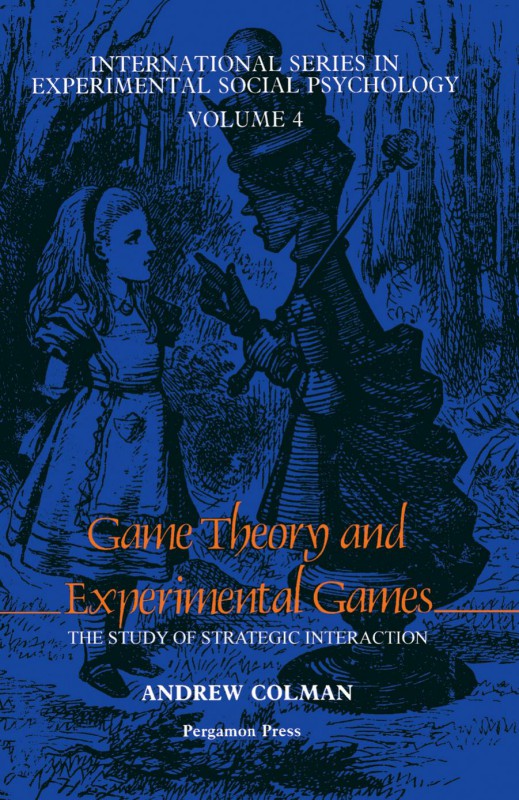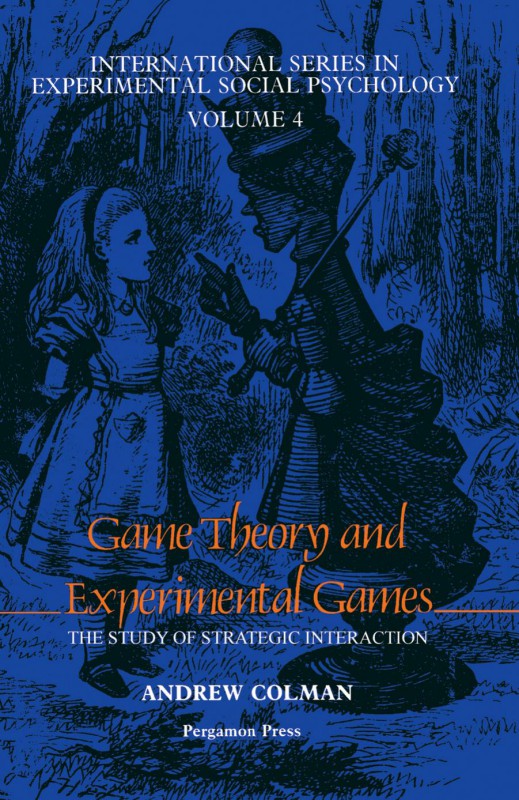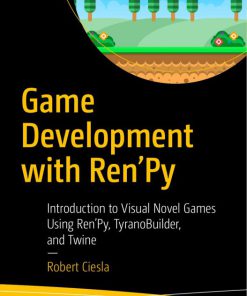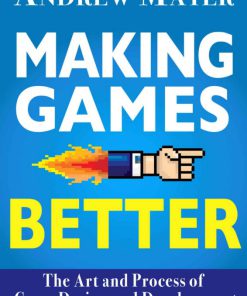(Ebook PDF) Game Theory and Experimental Games The Study of Strategic Interaction 1st edition by Andrew Colman 1483137147 9781483137148 full chapters
$50.00 Original price was: $50.00.$25.00Current price is: $25.00.
Authors:Andrew M. Colman , Series:Strategic Studies [123] , Author sort:Colman, Andrew M. , Ids:9780080260709 , Languages:Languages:eng , Published:Published:Jun 1982 , Publisher:PERGAMON PRESS
Game Theory and Experimental Games: The Study of Strategic Interaction 1st edition by Andrew M. Colman – Ebook PDF Instant Download/DeliveryISBN: 1483137147, 9781483137148
Full download Game Theory and Experimental Games: The Study of Strategic Interaction 1st edition after payment.

Product details:
ISBN-10 : 1483137147
ISBN-13 : 9781483137148
Author : Andrew Colman
Game Theory and Experimental Games: The Study of Strategic Interaction focuses on the development of game theory, taking into consideration empirical research, theoretical formulations, and research procedures involved. The book proceeds with a discussion on the theory of one-person games. The individual decision that a player makes in these kinds of games is noted as influential as to the outcome of these games. This discussion is followed by a presentation of pure coordination games and minimal situation. The ability of players to anticipate the choices of others to achieve a mutually beneficial outcome is emphasized. A favorable social situation is also influential in these kinds of games. The text moves forward by presenting studies on various kinds of competitive games. The research studies presented are coupled with empirical evidence and discussion designed to support the claims that are pointed out. The book also discusses several kinds of approaches in the study of games. Voting as a way to resolve multi-person games is also emphasized, including voting procedures, the preferences of voters, and voting strategies. The book is a valuable source of data for readers and scholars who are interested in the exploration of game theories.
Game Theory and Experimental Games: The Study of Strategic Interaction 1st Table of contents:
PART 1: BACKGROUND
Chapter 1. Introduction
1.1 Intuitive Background
1.2 Abstract Models: Basic Terminology
1.3 Skill, Chance, and Strategy
1.4 Historical Background
1.5 Summary
Chapter 2. One-Person Games
2.1 Games Against Nature
2.2 Certainty
2.3 Risk
2.4 Utility Theory
2.5 Uncertainty
2.6 Summary
Chapter 3. Pure Coordination Games and the Minimal Social Situation
3.1 Strategic Collaboration
3.2 Pure Coordination Games
3.3 The Minimal Social Situation
3.4 Summary
PART 2: THEORY AND EMPIRICAL EVIDENCE
Chapter 4. Two-Person, Zero-Sum Games
4.1 Strictly Competitive Games
4.2 Extensive and Normal Forms
4.3 Games With Saddle-Points
4.4 Games Without Saddle-Points
4.5 Dominance and Admissibility
4.6 Methods for Finding Solutions
4.7 Ordinal Payoffs and Incomplete Information
4.8 Summary
Chapter 5. Experiments With Strictly Competitive Games
5.1 Ideas Behind Experimental Games
5.2 Review of Research on Non-Saddle-Point Games
5.3 Review of Research on Saddle-Point Games
5.4 Critique of Experimental Gaming
5.5 Experiment I: Abstract and Lifelike Strictly Competitive Games
5.6 Summary
Chapter 6. Two-Person, Mixed-Motive Games: Informal Game Theory
6.1 Mixed-Motive Games
6.2 Classification of 2 x 2 Mixed-Motive Games
6.3 Leader
6.4 Battle of the Sexes
6.5 Chicken
6.6 Prisoner’s Dilemma
6.7 Comparison of the Archetypal 2 x 2 Games
6.8 Metagame Theory
6.9 Summary
Chapter 7. Experiments With Prisoner’s Dilemma and Related Games
7.1 The Experimental Gaming Literature
7.2 Strategic Structure
7.3 Payoffs and Incentives
7.4 Circumstances of Play
7.5 Responses to Programmed Strategies
7.6 Sex Differences
7.7 Attribution Effects
7.8 Investigations of Ecological Validity
7.9 Experiment II: Abstract and Lifelike Prisoner’s Dilemma Games
7.10 Experiment III: Abstract and Lifelike Chicken Games
7.11 Summary
Chapter 8. Multi-Person Games: Social Dilemmas
8.1 Multi-Person Game Theory
8.2 Non-Cooperative Games: Equilibrium Points
8.3 Cooperative Games: Characteristic Functions
8.4 Harold Pinter’s “The Caretaker”
8.5 The Shapley Value
8.6 The Dollar Auction Game and the Concorde Fallacy
8.7 Multi-Person Prisoner’s Dilemma
8.8 General Theory of Compound Games
8.9 Summary
Chapter 9. Experiments with Coalition, Auction, & Social Dilemma Games
9.1 Multi-Person Experimental Games
9.2 Coalition Formation
9.3 Auction Games and Psychological Traps
9.4 N-Person Prisoner’s Dilemma
9.5 Experiment IV: Abstract and Lifelike N-Person Prisoner’s Dilemmas
9.6 Summary
PART 3: APPLICATIONS
Chapter 10. Sincere Voting and Collective Choice Theory
10.1 Background
10.2 Alternatives, Voters, Preferences
10.3 Axioms Concerning Individual Preferences
10.4 Voting Procedures
10.5 Condorcet’s Paradox
10.6 Probabilities of Cyclic Majorities
10.7 Arrow’s Impossibility Theorem
10.8 The Borda Effect
10.9 Summary
Chapter 11. Strategic Voting
11.1 Optimal Voting Strategies
11.2 Historical Background
11.3 Insincere Voting and Equilibrium Points
11.4 The Classical Solution: Dominance and Admissibility
11.5 Sophisticated Voting
11.6 Anticipated Decisions and Multistage Solutions
11.7 General Results on Strategic Voting
11.8 Is Strategic Voting Unfair?
11.9 Empirical Evidence
11.10 Summary
Chapter 12. Theory of Evolution: Strategic Aspects
12.1 Historical Background
12.2 Strategic Evolution
12.3 Animal Conflicts and Evolutionarily Stable Strategies
12.4 An Improved Multi-Person Game Model
12.5 Empirical Evidence
12.6 Summary
Chapter 13. Moral Philosophy and Practical Problems of Strategy
13.1 Game Theory and the Conduct of Life
13.2 Rationality and Self-Interest
13.3 Kant’s Categorical Imperative
13.4 Rousseau’s Social Contract
13.5 Evolution and Stability of Moral Principles
13.6 Summary
People also search for Game Theory and Experimental Games: The Study of Strategic Interaction 1st:
game theory games examples
what is game theory and its applications
game theory experiments
game theory experiments in class
game theory and psychology











